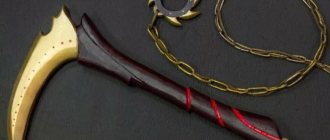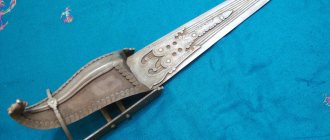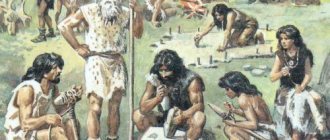Valhalla (or Valhalla) was a paradise for the ancient Scandinavians, where the Vikings dreamed of going after death. The word “Valhalla” can be translated from the ancient Icelandic language as “the hall of the fallen” (warriors in battle). You can often come across different spellings of the word "Valhalla". This is Valhalla, Valhalla, Valhalla. Any transcription is acceptable.
According to the legends of the ancient Scandinavians, Valhalla is the palace of Asgard, where the god Odin rules. The owner of Valhalla asks the warriors whether they died with dignity and takes the best into his squad, which will fight with him when Rognarok comes.
The hard road to Valhalla
The road to Valhalla is difficult and only worthy warriors will find it. Not every warrior who fell in battle was worthy to enter Valhalla. Only the best got there. Some of those killed did not reach Valhalla, but were “redirected” to Folkvangr to Freya, which was considered not so honorable. The Vikings who were lucky enough to get to Odin became his personal guard (in some sources they are called ice warriors). In order for the road to Valhalla to lead the warrior specifically to Odin, the Viking had to fall with weapons in his hands. Mortally wounded warriors asked their comrades to put a sword or an ax in their hands, otherwise the road to Valhalla would not open to him.
It should be separately mentioned that the weapon was a kind of conductor to Valhalla. Without a sword or other weapon, the road to Valhalla will not open, and the warrior will forever wander in search of it.
The ice warriors of Valhalla fight each other in the morning until the only survivor remains. After this, all the fallen are resurrected, their wounds heal, and severed limbs grow back. After the battle, the heroes’ path lies to Odin’s hall, where they are met by the owner of Valhalla himself. There the brave men feast until the evening, remembering their exploits and honoring today's winner. At night, the Vikings disperse throughout Valhalla, and lovely maidens come to them, who please them until the morning. Some believe that warriors who find themselves in their paradise have fun with Valkyries, but the beauties of the night are not them at all.
Joining the ranks of Odin's warriors could be done in several ways:
- The owner of Valhalla took the best fighters for himself, and the Vikings believed that Odin could specifically send Valkyries to the battlefield so that they would interfere with the heroes’ fight. If a warrior suddenly stumbled or missed, it meant that Odin wanted to quickly get him into his palace;
- If a warrior lived to old age, he could commit ritual suicide by hanging himself from an oak tree. Thus, he repeated the sacrificial suicide of Odin, who hanged himself in order to comprehend the wisdom of the runes;
- The most severe was the third option - courageous death through a specific execution called “bloody eagle”. If a Viking endured such an execution without screams and groans, the entrance to Valhalla was considered open for him, and he could count on a place of honor among Odin’s ice warriors;
- It is believed that there is no other way to Valhalla, but there was another cruel custom. The Vikings rarely allowed captured enemies to die with dignity, but the courageous warriors knew how to get to Valhalla in this case. They asked to rip open their stomachs and nail their intestines to a high pole. Then the brave man walked around the pillar, wrapping his guts around it and taunting his enemies. If he did not lose his composure and bravely endured the pain, his enemies burned his body, asking Odin to accept the valiant warrior.
About Valkyries
Mentioned above is how to get to the mysterious place called Valhalla. Photos of pictures reflecting its main features can also be seen in the article. It is impossible not to mention the guides who help the warriors who have found their death get to the palace of the leader of the Aesir. Of course, we are talking about Valkyries.
Valkyries are warlike maidens, on whom the distribution of deaths and victories in battles directly depends. They obey the supreme god Odin and supply brave fighters for his army. There are various assumptions about the appearance of the Valkyries. For example, in later Scandinavian myths, warlike maidens look like Nordic beauties with long light curls and bright blue eyes. Valkyries are dressed in armor, their helmets are crowned with bird wings or horns, and their weapons are spears and swords.
How Valhalla and the halls of Odin work
The halls of Valhalla are a large banquet hall, but instead of a roof it has the golden shields of Odin's guard (Einherjar). The walls are made of huge copies of the heroes who feast in the hall. In the morning, when leaving for battle, the warriors dismantle the walls and roof, essentially taking the palace with them.
There are a total of 540 doors in the feast hall, from each of which 800 fighters should emerge when Rognarok comes. In total there should be 432,000 warriors ready to support the gods in the final battle with the giants.
Despite the fact that women occupied a rather privileged position in Viking culture and often fought on an equal basis with men, there is not a single mention in the Scandinavian sagas of where beautiful warriors end up. The only woman mentioned in the sagas was Brünnhilde, who was exiled to earth as punishment and deprived of her Valkyrie status. In the ancient sagas, she is considered neither a human nor a Valkyrie.
In the very middle of Valhalla stands the throne of Odin, from which the stern god examines all the worlds with his only eye, so as not to miss the beginning of the end of the world.
It is worth noting that such a wild and harsh life was seen by the pagan Vikings as a real paradise, because their real life was a series of battles, murders and drunken fun.
Dictionary
Wingolf, Valhalla, Valhalla (Old Norse valholl, “hall of the slain”), in Scandinavian mythology, located in the sky, belonging to Odin, the home of the Einherjars - brave warriors killed in battle, who feast there, drink the inexhaustible honey milk of the Heidrun goat and eat the inexhaustible boar meat of Sehrimnir (it is cooked in the Eldhrimnir cauldron by cook Andhrimnir). Instead of fire, Valhalla was illuminated by shining swords. As a heavenly kingdom for the elect, it apparently differentiated relatively late from the underground kingdom of the dead (hel). In the "Speeches of Grimnir" ("Elder Edda") it is correlated with Gladsheim ("dwelling of joy"), and in the "Younger Edda" the dwelling in which Odin and "all people worthy and righteous" live is called Gimle ("protection from fire ") or Vingolv ("abode of bliss"). eat.
What was Valhalla like in Christian times?
It is very interesting what opinion the first Christians had about Valhalla when they learned about the paradise of the harsh northern warriors. The first missionaries who visited the Scandinavians and learned aspects of their harsh religion were amazed to the core. Christians already considered the Vikings to be real demons, and when they learned that their paradise resembled Christian hell, they were completely confirmed in their opinion. The daily resurrection of soldiers in order to kill each other again the next day was interpreted by Christians as the torment of sinners in hell. Odin himself in this place was the embodiment of Satan.
The fearless warriors of the north, who rushed into battle against enemy troops several times superior to them and were not afraid of death, caused horror among civilized Europeans. And the Viking elite - berserkers and ulfhednars - suggested thoughts of tamed demons from hell.
Despite the adoption of Christianity by the Norwegians, many pagans fled to Iceland, where the religion of Asatru (which means faith in the Ass) has survived to this day. Modern Icelandic special forces warriors still use the Viking battle cry “Till Valhall!”, which translated into our language means “To Valhalla!”
What is VALHALLA - meaning, definition in simple words.
In simple words, Valhalla is a place of eternal glory, where the noblest of fallen warriors live with Odin. They say that only the bravest and most talented are selected to live in this luxurious paradise. As you know, Valhalla is a country where there is a lot of food and drink, especially honey and meat (the most favorite delicacies for all warriors). Everything in Valhalla is specially designed to comfort the fearsome warriors in their afterlife.
Gates of Valhalla
To enter Valhalla, dead heroes must unlock the gates of Valgrind. Their meaning is still not clear, although logically they should lock Valhalla from unwanted visitors. This theory is also supported by the fact that one of the Scandinavian Eddas clearly states that only the dead can open the gates of Valgrind. The lock of this gate is one of the unique artifacts that were made by the dark elves.
These characters are the prototype of the dark elves, so widely popularized thanks to modern games. Although, unlike games in which dark and light elves are close relatives, the Scandinavian Eddas say that dark elves have a completely different nature than light elves.
The castle has magical powers; anyone unworthy to touch it will be bound forever when touched.
Some folklorists and publicists in Sweden (in particular Viktor Rydberg) believe that the name of the gates of Valhalla can be translated as “loudly clapping.” This statement is based on an ancient belief that linked the sound of thunder and the opening of the gates of Valgrind into one whole.
"Expedition" by Eric the Red
Somewhere in 982-986. n. e. Scandinavian Vikings, led by Erik the Red, sailed from Iceland to Greenland on 14 ships to establish a settlement there. Unfortunately, the only source of information about this event, the Greenlanders' Saga, does not contain a detailed chronology.
The only type of agriculture possible on this land at that time was cattle breeding. The warm waters of the Gulf Stream softened the climate in the south of the island, which was reminiscent of the shores of Iceland familiar to the Scandinavians.
According to legend, Eric lied to the colonists, telling them about rich pastures before sailing to a new land in order to attract their attention. Even the name for the island was invented accordingly - Greenland (“Green Land”), although most of it is covered with snow and ice all year round.
So, in the 10th century. Colonists from Europe founded the first settlements in Greenland: Eastern (Eystribyggd) and Western (Vestribyggd). The remains of the first are located near the settlement of Qaqortoq, and the ruins of the second, where Sigrid Bjornsdottir and Thorstein Olafsson were married, were discovered near the city of Nuuk.
There was also a Central Settlement, but almost nothing is known about it.
Viking SettlementShutterstock
At first, about 350 people lived in all three settlements, but new settlers arrived from Iceland and Norway, children were born... During the excavations, archaeologists counted the remains of 400 residential buildings. And in the 13th century. 5-6 thousand people could live in both settlements - a lot for Europe at that time. For example, in 1377-1381. In England, out of 250 cities, only two - London and York - had more than 10 thousand inhabitants. 15-25 thousand people lived in Cologne and Regensburg, in Strasbourg, and they were considered megacities of that time.
Warriors of Odin Einherjar – selected from the best
In the culture of the ancient Scandinavians one can find quite detailed descriptions of the heroes of Valhalla, the Einherjar. Although this word was used to call great heroes, its exact meaning is lost and no one knows what it really means.
Odin's warriors battle each other to hone their skills as they face off against terrible giants during the final battle of the gods. Since the wounds of the Eitherya always heal, they are immortal.
During the feast in the halls, the fallen heroes drink the magical honey that flows from the udder of the goat Heidrun. Scandinavian mythology does not give us an answer to the question of whether this drink is alcoholic, although knowing the life of the Vikings, it is not difficult to imagine that they would be bored in paradise without drinking. The main dish at the feast is the meat of the huge boar Sehrimnir, which, in addition to being able to feed an unlimited number of warriors, is reborn every day.
The underworld of Egyptian mythology
The Egyptians also have several legends that vividly describe their afterlife, which was called the Duat. However, Egyptian mythology is also one of the most ancient and confusing, which causes certain inconsistencies. So, for example, during the Ancient Kingdom, Anubis was listed as the ruler of the Duat, and in later mythology, Osiris was called the ruler of the Duat (you can read about this in our articles dedicated to these gods). But, let's return to the Duat.
In terms of their attitude towards the dead, the Egyptians differed significantly from other peoples. The fact is that death, as such, did not exist for them, and the transition to another world was the next stage of life. It was believed that the dead exist just like the living, that they also need various things and the attention of loved ones.
The Egyptians believed that a person consists not only of the body, but also of several other parts:
- Sah – body.
- Ba – soul.
- Ka is life force.
- Ah - spirit.
- Shuit is a shadow.
- Ren is a name.
There is even a legend about this, when a person wanted to die, but his spirit simply refused to descend into the Duat.
The Egyptians believed that they would achieve well-being in the afterlife only if they preserved the body of the deceased. That is why embalming was widely developed among them. In addition, it was believed that everyone who died must reach a place called Sekhet Iaru - something like a Christian Paradise. However, a person could be forced to cultivate the fields there. That is why figurines and other devices were placed in people’s graves, which could be used to pay off work.
However, any afterlife journey began with Anubis flying over the body of the deceased and taking him to the kingdom of Osiris. There the deceased had to go through a trial, where he was judged by Osiris and 42 other deities seated in the Hall of Truth. They were able to read all the actions a person performed during his lifetime.
At the end of the trial, the person, or rather his soul, had to swear that he had not committed any actions displeasing to the gods, that he had not harmed other people and animals, etc., in general, that he had led a more or less righteous lifestyle. It was imperative to tell the truth and not take an oath if you led a sinful lifestyle.
After this, Anubis took out the person’s heart and placed it on one side of the scale. A feather from the headdress of the goddess Maat was placed on the other side of the scale by the god Thoth. As a result, if the heart outweighed the feather, then the person died forever, and his heart was eaten by a monster. If the feather outweighed, then the person gained eternal life and the opportunity to get to Sekhet Iara.
Valhalla in the works of Richard Wagner
Composer Richard Wagner was very interested in ancient Germanic mythology, which is similar to Old Norse. It was his works that played a significant role in the popularization of Valhalla and everything connected with it. The most famous pieces of music associated with the Viking paradise are “Entry of the Gods into Valhalla” and “Ride of the Valkyries.”
To a modern person, the Viking paradise may seem boring and monotonous, but for the warriors of that time, Valhalla was the realm of dreams.
Vikings - merchants, Christians, republicans
The Scandinavian colonialists traded with Iceland and Europe: they sold walrus tusk, wool, meat, fish, fur and seal skins - receiving iron, timber and other goods scarce for the island.
The settlers, along with Scandinavia, adopted Christianity. In 1126, a Greenlandic Catholic diocese appeared, subordinate to the bishop of the Norwegian city of Trondheim, and at least five churches were built. The flock needed priests, and they could only be sent from Europe.
Colonists visited North America, 500 years before Columbus. They even founded a settlement in Newfoundland (the coast of modern Canada). And during excavations of the islanders’ houses, bison skin was found, which lives only in North America.
For a long time, Greenland was an independent republican state - a rare phenomenon in Medieval Europe, where almost all countries were monarchies.
Viking House (reconstruction)Shutterstock
In 1261, the Vikings of Greenland swore allegiance to the King of Norway. In exchange for paying taxes, he undertook to send them a ship every year with iron and timber, which were scarce on the island. Icelanders and Greenlanders paid the king every six years. Interesting: in 1327, a ship sailed from Greenland to Bergen, Norway, with a tax of 260 walrus tusks - this cargo was worth more than all the wool sent to the king over 6 years from 4,000 Icelandic farms.
In 1380, Norway, together with its dependent territories, entered into a union with Denmark. Since then, Greenland has been ruled by Danish kings.
Version 5. Pirate attack
This hypothesis is proposed by the American writer Kirsten Seaver in her book “Frozen Echoes”.
In the XIV-XV centuries. they kidnapped people and sold them into slavery in the slave markets of North Africa and the Middle East.
For example, in 1627 Iceland was attacked by pirates. Robbers from the Maghreb (in the territory of modern Algeria and Morocco) sailed more than 3 thousand km and captured more than a hundred Icelanders. Many of them never returned to their homeland.
Pirates could theoretically cover the distance to Greenland. If after the raid the weak and sick remained in the settlement, they would die by starvation. Corsairs usually did not keep records of their “exploits,” and captives could die in slavery, so Europe did not know the details of the death of a distant settlement.
Viking observation structureShutterstock









